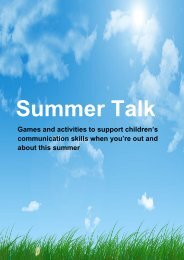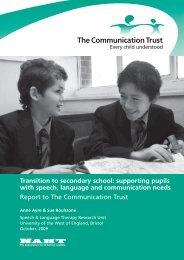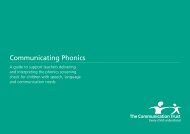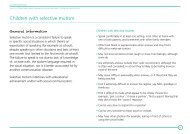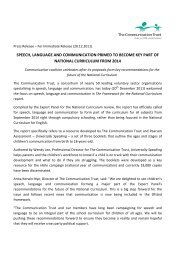Don't Get Me Wrong - The Communication Trust
Don't Get Me Wrong - The Communication Trust
Don't Get Me Wrong - The Communication Trust
You also want an ePaper? Increase the reach of your titles
YUMPU automatically turns print PDFs into web optimized ePapers that Google loves.
Introduction<br />
Almost everything we do involves speech, language and<br />
communication. Being able to make our needs known,<br />
expressing our likes and dislikes, interacting with others and<br />
building relationships are life skills we cannot afford to be<br />
without. Yet so many of us take these skills for granted. For<br />
some children and young people these skills are much harder to<br />
grasp and develop than for others; they have speech, language<br />
and communication needs (SLCN).<br />
Children and young people with SLCN have various difficulties with speech, language<br />
and communication which might include their ability to interact with others, manage<br />
their emotions and access the curriculum. Up to 10% of all children will have<br />
long-term, persistent SLCN 1 . <strong>The</strong>y may need direct and specific teaching with the<br />
involvement of a speech and language therapist (SLT) and / or specialist teacher in<br />
order to make progress. Support and understanding from those around them is crucial.<br />
Difficulties with speech, language and communication can impact on:<br />
• Being able to understand what’s happening and take part in lessons<br />
• Learning to read and write<br />
• Being able to think things through<br />
• Being able to manage your feelings<br />
Every child or young person with SLCN is different, so it is often useful to look at the<br />
nature and impact of their difficulties rather than any labels they may have. SLCN is<br />
also common in children and young people who may have other diagnoses such as an<br />
autism spectrum disorder and learning difficulties, so SLCN is also considered in these<br />
contexts. However many children with SLCN may not have been identified at all.<br />
1 Law et al (2000) Provision for children’s speech and language needs in England and Wales: facilitating communication<br />
between education and health services DfES research report 239<br />
4 Don’t <strong>Get</strong> <strong>Me</strong> <strong>Wrong</strong>




